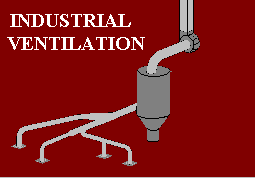HVAC AND INDUSTRIAL VENTILATION DUCT DESIGN©
by Bill Smith, president of Elite Software

 Sizing ductwork for standard hvac applications is daunting enough, but doing it for industrial ventilation and exhaust systems can be hair raising. At first glance there seems to be great similarity in the design goals of these different types of duct systems making one job as easy as the other. But ventilation and exhaust system duct sizing has quite a few more wrinkles than standard hvac duct design.
Sizing ductwork for standard hvac applications is daunting enough, but doing it for industrial ventilation and exhaust systems can be hair raising. At first glance there seems to be great similarity in the design goals of these different types of duct systems making one job as easy as the other. But ventilation and exhaust system duct sizing has quite a few more wrinkles than standard hvac duct design.
The main goal of designing hvac duct systems is to use the lowest cost (read smallest) duct sizes that can be used without violating certain sizing constraints. For example, hvac duct sections are typically  sized so that air velocities don't exceed 400-800 feet per minute and the pressure loss per 100 feet of duct length does not exceed 0.1" wg. These constraints effectively limit how small ducts can be sized.
sized so that air velocities don't exceed 400-800 feet per minute and the pressure loss per 100 feet of duct length does not exceed 0.1" wg. These constraints effectively limit how small ducts can be sized.
If high air velocities and a large pressure drop per 100 feet of duct are allowed, ducts can be sized relatively small. But excessive noise and a large total pressure drop necessitating a powerful and noisy fan are almost certain results of downsized duct system.
Still, velocity constraints can be varied for individual duct sections so that duct sizes can be selectively minimized without adversely affecting noise considerations. Likewise, the maximum allowable pressure drop per 100 feet of duct can sometimes be increased when it is known that the resulting greater pressure loss is still within the capacity of the fan.
Besides meeting the desired sizing constraints, an hvac duct system should be routed so as to minimize the individual lengths of the various duct runs. Optimally routing duct work minimizes material costs and helps to create a naturally balanced system where the static pressure and air velocities available at each diffuser are as similar as possible. A computer program can help to calculate pressure losses and air velocities, but intelligent placement of the air handler and routing of the ductwork are still the art of the hvac designer.
Except for differences in desired velocities and pressure drops, all of the above would seem to apply to industrial ventilation and exhaust duct systems. This is not so for several reasons. Industrial ventilation systems routinely utilize components rarely seen in hvac duct systems such as hoods, dust collectors, blast gates, and other such items.
These unique components not only require special consideration in calculating their pressure loss, they also greatly influence the design of the duct system. For example, a hood usually has slots through which particulate or gases are drawn through. For the hood to work properly, the connecting ductwork must allow sufficient velocity (typically 3,500-4,500 fpm) so that the particulate stays in suspension of the transporting air.
The dust collector of a ventilation/exhaust system not only contributes a large pressure loss, it can also vary the density of the air stream if it is a wet collector where moisture is added. Density changes at the collector thus affect the pressure loss calculations through all subsequent duct work.
Whereas the goal of an hvac duct system design is to use the smallest possible duct sizes that do not violate certain constraints, the goal of a ventilation/exhaust system design is to use the largest duct sizes that will still maintain the minimum velocity needed to keep particulates in suspension.
In ventilation/exhaust system design, maintaining the minimum velocity to keep particles in suspension is absolutely critical. However, maintaining high air velocities requires considerable fan power and electric energy consumption. If air velocities are maintained above what's necessary, a significant penalty is paid on operating costs. Not to mention that an already noisy system gets even louder.
The extra material expense of large ducts is usually insignificant when compared to the operating costs saved on fan energy. However, ducts can only be made so large before the air velocity begins to fall below the minimum required. Hence, good ventilation/exhaust system design strives for maximum useable duct sizes while optimal hvac duct design aims for the smallest practical sizes.
Perhaps even more than sizing ductwork, the real problem in ventilation/exhaust system design is balancing the static pressure at each converging junction of ductwork. Industrial ventilation and exhaust systems consist mostly of hoods with ductwork that converges back to a collector and fan. Weye fittings typically connect the converging air streams from hoods.
As two air streams converge, it is important for the static pressure in each duct branch leading to the junction calculate to nearly equivalent values. If they do not calculate within a 5% difference, the desired cfm flow quantities will not occur in the actual operating duct system.

Physics laws will always make the actual converging air streams have the same static pressure, but the cfm flow of air will automatically adjust to make the pressure losses balance. If the designer has not carefully calculated and balanced the static pressure losses for his desired air flows, the actual installed duct system will simply not perform as required. Hoods will draw whatever air quantity the actual static pressure values dictate and completely ignore the wishes of the hapless designer. The industrial ventilation/exhaust system designer has a number of tools at hand to make static pressures of converging air streams balance for his desired flow rates. The designer can change the sizes of the converging duct work, change a fitting on one of the duct sections, change some hood characteristics, or use a blast gate.
If the designer has followed the usual guideline of initially sizing the duct sections as large as allowed by the minimum velocity constraint, then increasing the duct size of one branch to increase it's static pressure is not an option. Therefore, to make the static pressures of two air streams balance, the designer usually attempts to decrease the static pressure of the branch with the highest value.
The first approach most designers try is to decrease the duct size of the branch with the highest static pressure. Sometimes this change alone will work, but often times it results in decreasing the static pressure of the highest branch too much so that an imbalance still exists. At this point the designer might go back to the first computed duct size, but try using higher loss fittings or a different hood configuration on the branch with the highest static pressure. Just changing the shape and number of slots on a hood can alter the static pressure of one branch enough to create a balance.
If all else fails in achieving calculated balanced static pressures, the designer might consider the use of a blast gate. A blast gate allows precise and strong static pressure control, but it is considered a last resort as a blast gate is a high maintenance item with potentially dangerous side effects. Gate slides can erode or become filled with particulate impeding their operation. A blast gate can also be improperly tampered with sometimes resulting in clogged ducts or injury to the operator.
Static pressure calculations and balancing strategy must be applied at every duct junction in a proposed ventilation/exhaust system design. This kind of extensive design analysis must be done before construction so that the actual installed system will perform as desired without expensive modifications. This is also true for an hvac duct system. It's just that hvac duct design does not require as much attention to balancing calculations as does a ventilation/exhaust system.
Certainly, the kind of painstaking analysis described above can be long and difficult to perform. Although not impossible to do by hand, it is much faster and easier to do with a computer program. There are many programs available for standard hvac duct design, but most of those programs do not have provisions for the special considerations of ventilation/exhaust system design. When shopping for a duct design program it is important to ask whether the program is meant strictly for hvac system design or whether it can also be used for ventilation/exhaust system design.
Whether designing standard hvac duct systems or a complex industrial ventilation/exhaust system, the more time put in up front for analysis the less problems and headaches there will be during and after construction.
 Mr. Smith welcomes your email about this article. - email
Mr. Smith welcomes your email about this article. - email
Copyright ©
Elite Software Development, Inc., webmaster@elitesoft.com
 Sizing ductwork for standard hvac applications is daunting enough, but doing it for industrial ventilation and exhaust systems can be hair raising. At first glance there seems to be great similarity in the design goals of these different types of duct systems making one job as easy as the other. But ventilation and exhaust system duct sizing has quite a few more wrinkles than standard hvac duct design.
Sizing ductwork for standard hvac applications is daunting enough, but doing it for industrial ventilation and exhaust systems can be hair raising. At first glance there seems to be great similarity in the design goals of these different types of duct systems making one job as easy as the other. But ventilation and exhaust system duct sizing has quite a few more wrinkles than standard hvac duct design. sized so that air velocities don't exceed 400-800 feet per minute and the pressure loss per 100 feet of duct length does not exceed 0.1" wg. These constraints effectively limit how small ducts can be sized.
sized so that air velocities don't exceed 400-800 feet per minute and the pressure loss per 100 feet of duct length does not exceed 0.1" wg. These constraints effectively limit how small ducts can be sized.